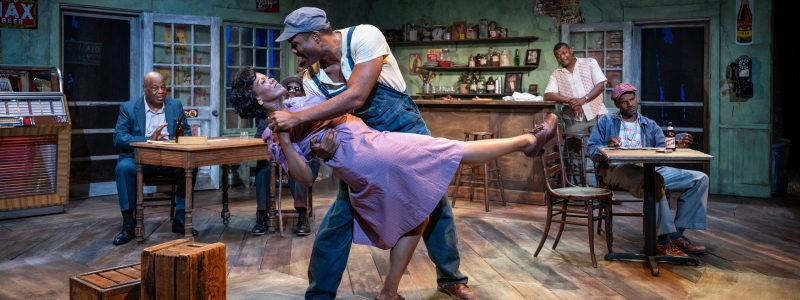Pre-Show Classroom Activity

Invite students to consider how they cope with and heal from challenging personal and global issues, and then to apply this same thinking and empathy to those who lived in East Texas at the time of East Texas Hot Links.
As always, please note that some steps of the activity may be condensed, eliminated, or extended based on the needs of your classroom.
Time and Place: Top o’ the Hill Café
Activity Preparation
- Supplies:
- Café Handout (one per group; alternatively, one per student)
- Students should have access to some combination of the following:
- Digital background materials and historical information located in this guide
- Internet access for student-led research
- Printed or digital access to front pages of the San Antonio Register in the summer of 1955
- Headphones for students to watch video resources (if needed)
- Set-Up:
- Put students into groups of approximately four.
- Designate one person from each group to act as a scribe on the handout.
- Students will have the opportunity to dig into research in their small groups. Based on your class, determine whether they might benefit from researching in pairs, whether each group should examine a select few resources, or whether each student should research independently before continuing their discussion.
This activity will take approximately 65 minutes.
Learning Sequence
- Establish that, today, the classroom is a cafe, and the class will be talking about some of the issues of the day, as people often do in community cafe settings. (~1 minute)
- Orient students to the first side of the Cafe Handout, walking them through each section of the “menu”: appetizers, entrees, and drinks. Each section of the menu corresponds to a discussion question. (~3 minutes)
- Prompt groups to generate ideas about the questions listed. As needed, chunk the steps of the discussion to support student engagement. Once groups have had a chance to discuss and reflect, invite a few students or groups to share. (~15 minutes)
- Appetizers: What are some smaller-scale, or personal, issues that affect you?
- Entrees: What are some larger, global issues that affect you?
- Drinks: What are some opportunities to heal from these issues?
- Tell students that they will now be engaging in a similar version of this activity, but with a twist: they will dive into sources that share what life was like in 1955 in America, and particularly East Texas. Have students flip over their handouts to Part 2, containing the below questions. (~2 minutes)
- Appetizers: What was happening in East Texas?
- Entrees: What was happening in the country/world?
- Drinks: What are some means and opportunities to heal from these issues?
- Direct students to the research materials provided: background information on the time period, front page newspaper articles from 1955, and/or student-selected articles and videos from the internet. Depending on the strategy for research, establish clear expectations for students to engage with these materials. (~5 minutes)
- Prompt students to begin their research. Once students have researched for 10 – 15 minutes, have them convene with their “cafe” group and fill out Part 2 of their handouts. (~15 – 20 minutes)
- Give students an opportunity to share their findings and reflections with the class. (~5 minutes)
- If time allows, spend some time discussing juke joints. Share this quote with the class:
- “From the road, juke joints seem to be nothing more than woozy broken-down shacks, apparitions from a not-so-proud past defined by Jim Crow laws. Until the late fifties, if you were black and lived in the rural South, they were practically the only public places to meet and greet or just while away idle hours…” (Joe Nick Patoski)
- Ask: What function and purpose might juke joints have served for Black people in the south? In what ways might they have been a refuge or place or healing? (~10 minutes)
- Guide students in some independent reflection, small group discussion, or whole-class discussion of the following prompts: (~10 minutes)
- Where are the places you find connection and community?
- What role does food play in creating community?
- Who do you gather with to discuss the issues of the world?
- What foods heal you?
- This activity aligns with the following standards:
- Illinois Arts Learning Standards
- Anchor Standard 11: Relate artistic ideas and works with societal, cultural, and historical context to deepen understanding.
- Common Core State Standards
- CCSS.ELA.RI7 Integrate and evaluate content presented in diverse formats and media, including visually and quantitatively, as well as in words.
- CCSS.ELA.RI1 Read closely to determine what the text says explicitly and to make logical inferences from it; cite specific textual evidence when writing or speaking to support conclusions drawn from the text
- CCSS.ELA.W7 Conduct short as well as more sustained research projects based on focused questions, demonstrating understanding of the subject under investigation.
- CCSS.ELA.RH6 Compare the point of view of two or more authors for how they treat the same or similar topics, including which details they include and emphasize in their respective accounts.
- Illinois Arts Learning Standards